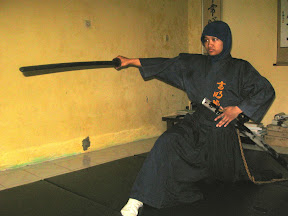
A sharp weapon shouldn't always be linked to violence, according to Sekiguchi Komei, 63 y.o. (when this article was written in 2008), a grandmaster iaijutsu, who, with his samurai sword, is actively campaigning for world peace.
In mid-April, Sekiguchi visited Sidoarjo in East Java to train students from the Komei Juku Shibucho institution of Indonesia. During his visit he also presented iaijutsu to dozens of students at one of the international schools in Surabaya.
Sekiguchi trained many students during his visit, including Angelina, 10, Alexander Rizki Maulana, 8, and Prince Muhammad Paradise, 7 --three students of the Komei Juku Shibucho institution.
In Indonesia, the use of dangerous weapons, such as firearms, is tightly regulated: Only adults who have been trained to use the sharp samurai sword can obtain a license from the police.
To the three young students, Sekiguchi said, "You have to be trained with discipline and must not be arrogant. The samurai isn't there to hurt other people but to protect the weak. And always make sure you care about peace."
He learned these lessons during his own training, "Because of my arrogance, my hands and my feet were cut by the sword when I was training. That was a worthy lesson."
Sekiguchi started learning iaijutsu in high school. Before that, he studied goju ryu karate, kendo, kobudo and yawara. He is now soke (head) of the 21st Hayashizaki generation.
Iaijutsu differs from kendo or wushu: Iaijutsu is a source of samurai knowledge that teaches the practitioner how to handle the sword with fast actions and supple movements.
Iaijutsu was developed by Hayashizaki Jinsuke Shigenobu. It comes from the Japanese word "i", which means "become" or "sit". For its practitioners, iaijutsu is considered the art of living in harmony.
"I live only for the samurai sword. This has been bushido (the noble way) for me," Sekiguchi told The Jakarta Post.
The samurai believe Japan was created by the sword, A sword was dipped into the sea, and when it was raised, the drops of seawater that fell from it were transformed into the archipelago now known as Japan.
So when Japan embraced a policy of modernization, many attitudes were colored by the turbulent events driven by samurai.
One of these issues was raised by John Logan, who wrote the book adapted for the screen as The Last Samurai, which told the story of the struggle between Katsumoto (Ken Watanabe) and Captain Nathan Algren (Tom Cruise), the American commander who became a turncoat.
Katsumoto went to war against Japanese troops who had been influenced by the United States, to defend the way of the samurai and reject Western modernization.
Sekiguchi, however, gives a different interpretation of the meaning of the modern samurai struggle, which created a new image of the samurai in Japan.
"The samurai should not be in the service of an employer. He is a servant for world peace."
Sekiguchi laments that Japanese youth have forgotten the way of the samurai and prefer to wear Western dress rather than to dress like a samurai. But he hasn't chosen to combat this trend by raising arms as in the heroic story of The Last Samurai.
Sekiguchi finds it difficult to hide his sorrow at the erosion of samurai culture, which includes the disappearance of the ritual known as genpuku. This is an initiation ceremony for 13-year-old boys, who receive a wakizashi, an adult name to become a samurai.
In response to these changes, Sekiguchi sought to influence the Japanese education curriculum to preserve the samurai culture for future generations. His efforts have been rewarded: The Japanese government now plans to include samurai lessons among its extracurricular activities at junior high and high schools.
"I'm not the only person who cares about the samurai. But I teach the younger generation to always remember the moral code that has underpinned Japan's rise from the destruction that followed the Hiroshima and Nagasaki bombs," he said.
Sekiguchi, who is also the president of the International Iaijutsu Association and president of the Japanese Association of Classical Martial Art Iaido, has visited 50 countries across Asia and Europe to teach iaijutsu to hundreds of students.
"Iaijutsu has taught me about respect, beauty and individual spirit. I have found freedom and peace through appreciating people as individuals, and other people," he said.
"Iaijutsu teaches us that though we differ one from another, we should not use those differences to build nationalism."
Sekiguchi told a story about one of his students called Jim, an American soldier who had fought in the Middle East.
While the war raged, Jim's emotions also raged: He couldn't stand to see the misery of the victims of the war. He longed for a peaceful life. To cure his anguish, he trained some people, including the children of Iraq war victims, in iaijutsu.
Besides training them in how to use the sword, Jim also taught the ideology of peace through iaijutsu.
"He keeps sending me letters which express the hope that peace can be created there. He is still training children who are victims in Iraq."
But Sekiguchi had little to say about the conflict in the Middle East, commenting only that it was political.
His single message is a simple one: "The wealth of a nation isn't measured by the quantity of its natural resources. If a nation wants to be rich, it should measure the worth of its moral values."
Source: Indra Harsaputra, The Jakarta Post
Surabaya May 26 2008, 10:19 AM























